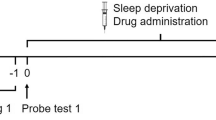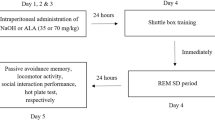Abstract
Chronic sleep deprivation (SD) is an overwhelming problem in young students. Firstly, we investigated whether different levels of pre-training SD had effects on spatial performance in adolescent rats. Rats were subjected to 2 or 4 h/day SD for 15 consecutive days. Morris water maze tests were conducted immediately after SD on experimental days 9–15. During the last 3 trials on the first training day, compared with their respective control animals, the rats with prior 4 h SD, but not 2 h SD, showed a significant reduction in percentage of the trials landing the platform without guidance (landing rate). During the whole 6 training days, the rats subjected to 4 h SD, not 2 h SD, spent longer time to locate the platform than the control rats did. In the probe test, the rats with 4 h SD and 2 h SD showed no significant difference with their respective control in time spent in the target quadrant and numbers of platform crossings. These results indicated that chronic prior 4 h SD, but not 2 h SD, impaired spatial acquisition capability in adolescent rats. Secondly, we explored whether huperzine A (Hup A), which has been proved to improve cognitive impairment in dementia, could prevent adolescent rats from chronic 4 h SD-induced learning decline. Hup A (0.1 mg/kg/day) was administered by gavage 30 min before the end of 4 h SD. With hup A treatment, the reduced landing rate was increased and the prolonged escape latency and distance were shortened, which suggested that hup A was promising in preventing the spatial cognitive deficits induced by repeated sleep restriction in adolescents.




Similar content being viewed by others
References
Schonauer M, Pawlizki A, Kock C, Gais S. Exploring the effect of sleep and reduced interference on different forms of declarative memory. Sleep. 2014;37(12):1995–2007.
Esposito MJ, Occhionero M, Cicogna P. Sleep deprivation and time-based prospective memory. Sleep. 2015;38(11):1823–6.
Louca M, Short MA. The effect of one night’s sleep deprivation on adolescent neurobehavioral performance. Sleep. 2014;37(11):1799–807.
Scullin MK, Bliwise DL. Sleep, cognition, and normal aging: integrating a half century of multidisciplinary research. Perspect Psychol Sci. 2015;10(1):97–137.
Loessl B, Valerius G, Kopasz M, Hornyak M, Riemann D, Voderholzer U. Are adolescents chronically sleep-deprived? An investigation of sleep habits of adolescents in the Southwest of Germany. Child Care Health Dev (Multicenter Study Research Support, Non-U.S. Gov’t). 2008;34(5):549–56.
Moore M. Behavioral sleep problems in children and adolescents. J Clin Psychol Med Settings. 2012;19(1):77–83.
Mednick SC, Cai DJ, Shuman T, Anagnostaras S, Wixted JT. An opportunistic theory of cellular and systems consolidation. Trends Neurosci (Research Support, N.I.H., Extramural Research Support, Non-U.S. Gov’t). 2011;34(10):504–14.
Tononi G, Cirelli C. Sleep and the price of plasticity: from synaptic and cellular homeostasis to memory consolidation and integration. Neuron. 2014;81(1):12–34.
Hagewoud R, Havekes R, Novati A, Keijser JN, Van der Zee EA, Meerlo P. Sleep deprivation impairs spatial working memory and reduces hippocampal AMPA receptor phosphorylation. J Sleep Res (Research Support, Non-U.S. Gov’t). 2010;19(2):280–8.
Yoo SS, Hu PT, Gujar N, Jolesz FA, Walker MP. A deficit in the ability to form new human memories without sleep. Nat Neurosci (Comparative Study Research Support, N.I.H., Extramural Research Support, Non-U.S. Gov’t). 2007;10(3):385–92.
Van Der Werf YD, Altena E, Schoonheim MM, Sanz-Arigita EJ, Vis JC, De Rijke W, et al. Sleep benefits subsequent hippocampal functioning. Nat Neurosci (Research Support, Non-U.S. Gov’t). 2009;12(2):122–3.
Kirszenblat L, van Swinderen B. The Yin and Yang of sleep and attention. Trends Neurosci. 2015;38(12):776–86.
Kalonia H, Bishnoi M, Kumar A. Possible mechanism involved in sleep deprivation-induced memory dysfunction. Methods Find Exp Clin Pharmacol. 2008;30(7):529–35.
Bowers MB Jr, Hartmann EL, Freedman DX. Sleep deprivation and brain acetylcholine. Science. 1966;153(3742):1416–7.
**ng SH, Zhu CX, Zhang R, An L. Huperzine a in the treatment of Alzheimer’s disease and vascular dementia: a meta-analysis. Evid Based Complement Altern Med. 2014;2014:363985.
Damar U, Gersner R, Johnstone JT, Schachter S, Rotenberg A. Huperzine A as a neuroprotective and antiepileptic drug: a review of preclinical research. Expert Rev Neurother. 2016;16(6):671–80.
Zheng W, **ang YQ, Li XB, Ungvari GS, Chiu HF, Sun F, et al. Adjunctive huperzine A for cognitive deficits in schizophrenia: a systematic review and meta-analysis. Hum Psychopharmacol. 2016;31(4):286–95.
Yang SR, Sun H, Huang ZL, Yao MH, Qu WM. Repeated sleep restriction in adolescent rats altered sleep patterns and impaired spatial learning/memory ability. Sleep (Research Support, Non-U.S. Gov’t). 2012;35(6):849–59.
Spear LP. The adolescent brain and age-related behavioral manifestations. Neurosci Biobehav Rev. 2000;24(4):417–63.
Wang J, Zhang HY, Tang XC. Huperzine a improves chronic inflammation and cognitive decline in rats with cerebral hypoperfusion. J Neurosci Res (Research Support, Non-U.S. Gov’t). 2010;88(4):807–15.
Tobler I, Deboer T, Fischer M. Sleep and sleep regulation in normal and prion protein-deficient mice. J Neurosci (Research Support, Non-U.S. Gov’t). 1997;17(5):1869–79.
Vorhees CV, Williams MT. Morris water maze: procedures for assessing spatial and related forms of learning and memory. Nat Protoc. 2006;1(2):848–58.
Qureshi AI, Giles WH, Croft JB, Bliwise DL. Habitual sleep patterns and risk for stroke and coronary heart disease: a 10-year follow-up from NHANES I. Neurology. 1997;48(4):904–11.
Luyster FS, Strollo PJ Jr, Zee PC, Walsh JK. Boards of Directors of the American Academy of Sleep M, the Sleep Research S. Sleep: a health imperative. Sleep. 2012;35(6):727–34.
Novati A, Hulshof HJ, Koolhaas JM, Lucassen PJ, Meerlo P. Chronic sleep restriction causes a decrease in hippocampal volume in adolescent rats, which is not explained by changes in glucocorticoid levels or neurogenesis. Neuroscience (Research Support, Non-U.S. Gov’t). 2011;8(190):145–55.
Soto-Rodriguez S, Lopez-Armas G, Luquin S, Ramos-Zuniga R, Jauregui-Huerta F, Gonzalez-Perez O, et al. Rapid eye movement sleep deprivation produces long-term detrimental effects in spatial memory and modifies the cellular composition of the subgranular zone. Front Cell Neurosci. 2016;10(132):1–13.
Tartar JL, Ward CP, McKenna JT, Thakkar M, Arrigoni E, McCarley RW, et al. Hippocampal synaptic plasticity and spatial learning are impaired in a rat model of sleep fragmentation. Eur J Neurosci (Research Support, N.I.H., Extramural Research Support, U.S. Gov’t, Non-P.H.S.). 2006;23(10):2739–48.
Guan Z, Peng X, Fang J. Sleep deprivation impairs spatial memory and decreases extracellular signal-regulated kinase phosphorylation in the hippocampus. Brain Res (Research Support, U.S. Gov’t, P.H.S.). 2004;1018(1):38–47.
Ward CP, McCoy JG, McKenna JT, Connolly NP, McCarley RW, Strecker RE. Spatial learning and memory deficits following exposure to 24 h of sleep fragmentation or intermittent hypoxia in a rat model of obstructive sleep apnea. Brain Res. 2009;19(1294):128–37.
D’Hooge R, De Deyn PP. Applications of the Morris water maze in the study of learning and memory. Brain Res Brain Res Rev. 2001;36(1):60–90.
Ohba T, Yoshino Y, Ishisaka M, Abe N, Tsuruma K, Shimazawa M, et al. Japanese Huperzia serrata extract and the constituent, huperzine A, ameliorate the scopolamine-induced cognitive impairment in mice. Biosci Biotechnol Biochem. 2015;79(11):1838–44.
Mao XY, Cao DF, Li X, Yin JY, Wang ZB, Zhang Y, et al. Huperzine A ameliorates cognitive deficits in streptozotocin-induced diabetic rats. Int J Mol Sci. 2014;15(5):7667–83.
Tang LL, Wang R, Tang XC. Huperzine A protects SHSY5Y neuroblastoma cells against oxidative stress damage via nerve growth factor production. Eur J Pharmacol. 2005;519(1–2):9–15.
Acknowledgments
We are grateful to students of Shanghai Medical College of Fudan University **ang-Da Meng, Zheng-Liang Li, **ao-** Malin, Wan-Na Chen, Ren-Jie Wang, Jie Chen, Bu-Qing Liang, Yin Wang, and Lin Lin for their contributions to the experimental work. We thank professor Zhi-Li Huang, Department of Pharmacology, School of Basic Medical Sciences, State Key Laboratory of Medical Neurobiology and Institutes of Brain Science, Fudan University for his critical comments.
Author information
Authors and Affiliations
Corresponding author
Ethics declarations
Conflict of interest
Author Su-Rong Yang declares that she has no conflict of interest. Author Huan-**n Sun declares that she has no conflict of interest. Author Zhen-zhen Hu declares that she has no conflict of interest. Author Si-Heng Wang declares that he has no conflict of interest. Author Hui Sun declares that she has no conflict of interest. Author Yin-Jia Xue declares that he has no conflict of interest. Author Chen-Bo Ye declares that he has no conflict of interest.
Disclosure statement
This was not an industry supported study. None of the authors has any financial interest or conflicts of interest related to this work.
Ethical approval
Experimental protocols were approved by the Shanghai Medical Experimental Animal Administrative Committee.
Source of funding
This study was supported by National Natural Science Foundation of China (81571296), Shanghai Committee of Science and Technology (11ZR1402000), and Shanghai Leading Academic Discipline Project (B119).
Additional information
S.-R. Yang, H.-X. Sun, and Z.-Z. Hu contributed equally to this work.
Rights and permissions
About this article
Cite this article
Yang, SR., Sun, HX., Hu, ZZ. et al. Repeated pre-training sleep restriction in adolescent rats impaired spatial performance. Sleep Biol. Rhythms 15, 57–65 (2017). https://doi.org/10.1007/s41105-016-0080-8
Received:
Accepted:
Published:
Issue Date:
DOI: https://doi.org/10.1007/s41105-016-0080-8




